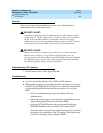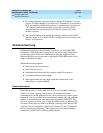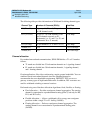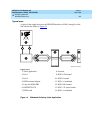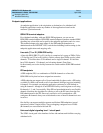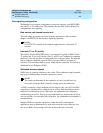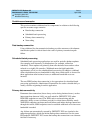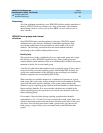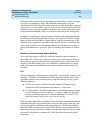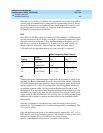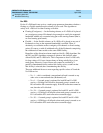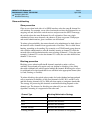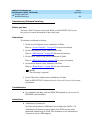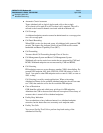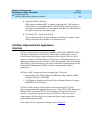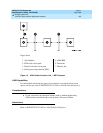
DEFINITY ECS Release 8.2
Administrator’s Guide
555-233-506
Issue 1
April 2000
Managing data calls
428Wideband Switching
15
Given this facility list concept, the algorithms have the ability to search for trunks,
by facility, in an attempt to satisfy the bandwidth requirements of a given
wideband call. If one facility does not have enough available bandwidth to support
a given call, or it is not used for a given call due to the constraints presented in the
following section, then the algorithm searches the next facility in the trunk group
for the required bandwidth (if there is more than one facility in the trunk group).
In addition to searching for channels based on facilities and required bandwidth,
Port Network (PN) preferential trunk routing is also employed. This PN routing
applies within each algorithm at a higher priority than the constraints put on the
algorithm by the parameters listed later in this section. In short, all facilities that
reside on the same PN as the originating endpoint are searched in an attempt to
satisfy the bandwidth of a given call, prior to searching any facilities on another
PN.
Direction of trunk/hunting within facilities
You can tell the system to search for available channels in either ascending or
descending order. These options help you reduce glare on the channels because
the system can search for channels in the opposite direction to that used by the
network. If an ISDN trunk group is not optioned for wideband, then a cyclical
trunk hunt based on the administration of trunks within the trunk group is still
available.
H11
When a trunk group is administered to support H11, the algorithm to satisfy a call
requiring 1,536 Kbps of bandwidth uses a fixed allocation scheme. That is, the
algorithm searches for an available facility using the following facility-specific
channel definitions:
■ T1: H11 can only be carried on a facility without a D-channel being
signaled in an NFAS arrangement (B-channels 1-24 are used).
■ E1: Although the 1,536 Kbps bandwidth could be satisfied using a number
of fixed starting points (for example, 1, 2, 3, and so forth), the only fixed
starting point being supported is 1. Hence, B-channels 1-15 and 177-25
always are used to carry an H11 call on an E1 facility.
If the algorithm cannot find an available facility within the trunk that meets these
constraints, then the call is blocked from using this trunk group. In this case, the
call may be routed to a different trunk group preference via Generalized Route
Selection (GRS), at which time, based on the wideband options administered on
that trunk group, the call would be subject to another hunt algorithm (that is, either
the same H11 algorithm or perhaps an N x DS0 algorithm described in a later
paragraph).



